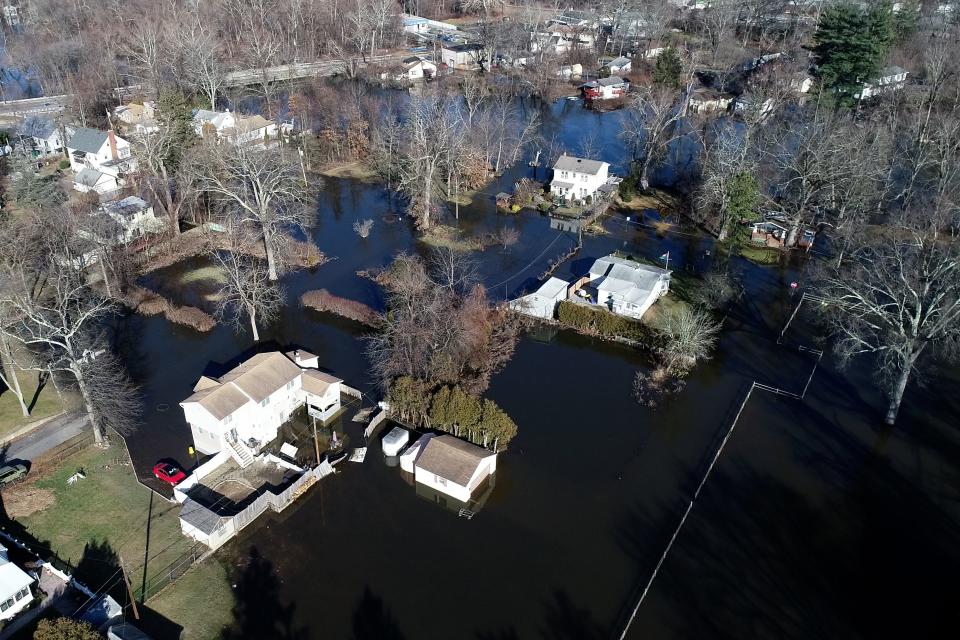NJ has new measures to protect homebuyers and renters from flood risk
- Oops!Something went wrong.Please try again later.
State officials have unveiled new and enhanced tools and technologies designed to provide prospective homebuyers and renters with critical information needed to make better-informed decisions on where they choose to live and how best to protect their property from flood damage.
The measures, which include the publication of new disclosure forms notifying of a property’s known flood history and potential flood risks, as well as the launch of a user-friendly internet lookup tool searchable by mailing address that identifies properties in flood hazard areas, implement provisions of flood risk disclosure legislation signed into law by Gov. Phil Murphy in June.
Sellers and landlords will be required to use the new forms, which are available on the Division of Consumer Affairs and Department of Community Affairs websites, beginning on March 20.
State officials noted Thursday that the new law makes New Jersey one of seven states in the country to receive an “A” grade on the Natural Resources Defense Council’s Flood Risk Disclosure Law Scorecard and was passed in response to the growing flood risks New Jersey is seeing as a result of climate change.
“As we continue to live with the impacts of climate change in our communities, it’s essential that we inform prospective homebuyers and renters of the risks in areas where they are looking to settle down,” Murphy said in a statement. “These new protections will enable prospective homebuyers and renters to stay a step ahead when it comes to finding the safest residence possible for themselves and their families.”
Before the adoption of New Jersey’s flood risk disclosure law, sellers and landlords were under no obligation to disclose a property’s flood history to potential buyers and tenants or inform them if the property is in a Federal Emergency Management Agency (FEMA) Flood Hazard Zone Area. Now they must make those disclosures before the signing of sales contracts, leases and lease renewals.

“Consumers deserve to make informed decisions when renting or purchasing a home,” Division of Consumer Affairs acting Director Cari Fais said in a statement. “The measures announced today provide consumers with the information they need to fully assess the potential risks and costs associated with a flood-prone property so they can prepare appropriately.”
Earlier: Murphy announces latest measures to protect NJ communities from floods
In accordance with the requirements of the flood disclosure law, the Division of Consumer Affairs, in consultation with the New Jersey Real Estate Commission, on Thursday released an updated version of New Jersey’s Seller’s Property Condition Disclosure Statement, a required form in which sellers of residential properties report any defects or problems with the residence to potential buyers.
Under a new heading titled “Flood Risk,” the updated disclosure form requires sellers to answer questions focusing on a property’s flood history and potential flood risk. Questions include whether a property is in FEMA’s Special Flood Hazard Area (“100-year floodplain”) or Moderate Risk Flood Hazard Area (“500-year floodplain”), whether the property has experienced flood damage or pooled water due to heavy rainfall or another natural flood event, and whether the property is subject to any requirement under federal law to be covered by flood insurance.
Also in accordance with the flood disclosure law, the Department of Community Affairs posted Thursday on its website a model notice to be used by landlords to inform their tenants of the flood risk of rental properties. The model notice, which will also be published in the New Jersey Register, contains questions about the flood risk of the property and space for landlords to answer yes, no or unknown, based upon the landlord’s knowledge. The model notice also contains basic information about flood insurance available to renters through FEMA’s National Flood Insurance Program and about the effects of climate change on flood risks in New Jersey.
Landlords must notify tenants in writing of the flood risk before a lease signing or lease renewal, effective 90 days after the Department of Community Affairs publishes the model notice. Exemptions from the notice requirements include dwelling units in premises containing not more than two such units; owner-occupied premises of not more than three dwelling units; and hotels, motels or other guest houses serving transient or seasonal guests.
To assist individuals with meeting the FEMA Flood Hazard Area disclosure requirements, the Department of Environmental Protection developed the Flood Risk Notification Tool. This online tool enables users to search properties by mailing address to identify whether a property overlaps with the FEMA Special or Moderate Flood Hazard Areas.
Users can also view additional flood risk information that is not required for disclosure but provides a fuller picture of a property’s flood risk, including information on sea-level rise projections of 3 feet (likely by 2070) and 5 feet (likely by 2100).
The tool offers users the ability to view a property’s flood risk using the map legend and sidebar or request a detailed flood report to be emailed to them. The report includes the property’s FEMA flood zone information to satisfy the new disclosure requirements as well as a description of what FEMA flood zones mean and how they are determined.
All of the supporting documents are at the Department of Community Affairs and Division of Consumer Affairs websites, as well as flooddisclosure.nj.gov.
This article originally appeared on MyCentralJersey.com: NJ aims to make homebuyers, renters aware of flood risk

